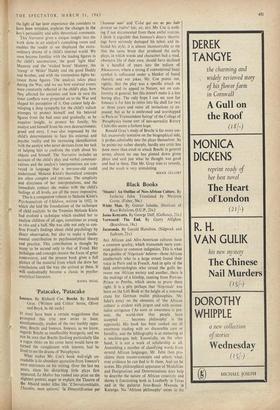The Child and his Objects
Narrative of a Child Analysis. By Melanie Klein. (Hogarth Press, 75s.)
THE Narrative of a Child Analysis describes the treatment of a ten-year-old boy who needed analysis because of severe neurotic symptoms and anxieties, one of the most crippling being a fear of other children so intense that it prevented him from having playmates. going out into the street alone or attending school. Owing to external circumstances the treatment could only last about four months, and it is described in full de- tail. Each session is reported in a separaee chapter (ninety-three in all), based on full notes taken immediately afterwards. The child's draw- ings are reproduced. Most chapters are followed by notes which represent the author's later find- ings on the sessions and which are of great fascination. In some of these she gives her reasons for certain interpretations, points out what in
the light of her later experience she considers to have been mistakes, explains the changes in the boy's personality and adds theoretical comments.
This Narrative gives a unique insight into the work done in an analyst's consulting room and enables the reader to see displayed the extra- ordinary drama of a child's internal world. We soon become familiar with the leading figures in the child's unconscious, the good 'light blue' Mummy and the 'wicked brute' Mummy, the 'tramp' or 'Hitler' Daddy and the good Daddy and brother, and with the tremendous fights be- tween those figures. The analysis takes place during the War, arid we see how external events were constantly reflected in the child's play, how they affected his anxieties and how in turn his inner conflicts were projected on to the War and shaped his perception of it. One cannot help de- veloping a deep sympathy for the child's valiant attempts to protect himself and his beloved figures from the bad ones and gradually, as he acquires insight, to protect his family, his analyst and himself from his own destructiveness, greed and envy. I was/ also impressed by the child's determination to face his external and Psychic reality and his increasing identification with the analyst who never deviates from her task of helping him to confront the truth about his objects and himself. The Narrative includes an account of the child's play and verbal communi- cations and the analyst's interpretations are con- veyed in language that a ten-year-old could understand. Melanie Klein's theoretical concepts are often complex and intricate. The simplicity and directness of her interpretations, and the immediate contact she makes with the child's feelings at all levels, are all the more impressive. This is a companion volume to Melanie Klein's Psychoanalysis of Childrett,_written in 1932, in which she laid the foundations of the technique of child analysis. In the Twenties Melanie Klein
had evolved a technique which enabled her to analyse children of all ages, sometimes as young as two and a half. She was able not only to con- firm Freud's findings about child psychology by direct observation, but also to make a funda- mental contribution to psychoanalytical theory and practice. This contribution is thought by many to be second only to that of Freud. Her technique and concepts remain the focus of great controversy, and the present book gives a full picture of the material from which she drew her conclusions and the way she arrived at them. It will undoubtedly become a classic in psycho- analytical literature.
HANNA SEGAL



































 Previous page
Previous page